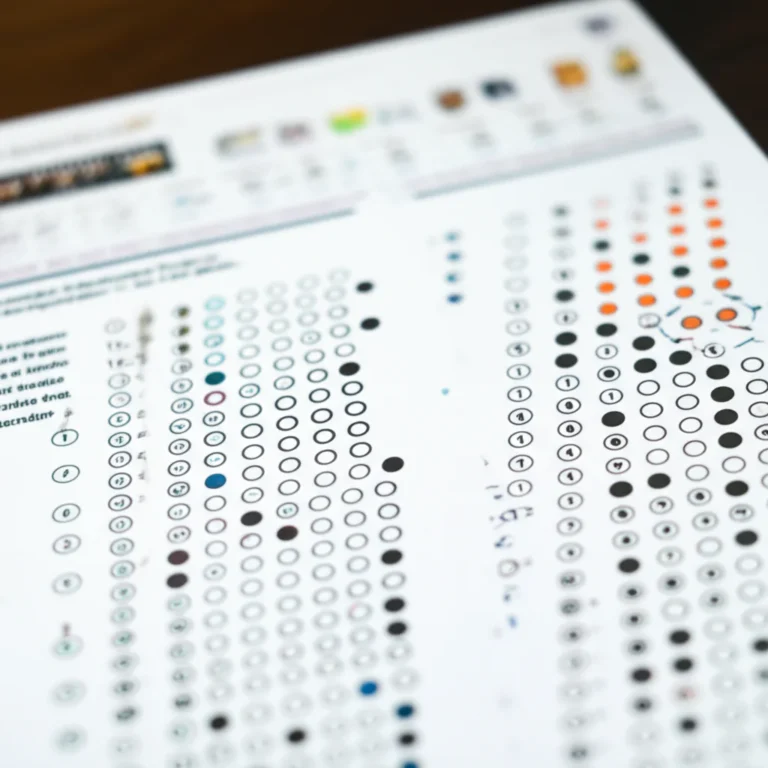Support our educational content for free when you buy through links on our site. Learn more
What Is a Normal IQ Score for Adults? 🧠 (2025 Ultimate Guide)
Have you ever wondered what your IQ score really means? Maybe you’ve heard that the average IQ is 100, but what does “normal” actually look like for adults? Is a score of 110 impressive or just slightly above average? And how do these numbers translate into real-world smarts? Well, buckle up — we’re about to unravel the fascinating story behind IQ scores, from their surprising history to what your number says (and doesn’t say) about you.
Here’s a little teaser: did you know that only about 2% of adults score above 130, landing in the “very superior” range? But the vast majority cluster comfortably in the “normal” zone, which isn’t just a bland middle ground — it’s the sweet spot of everyday brilliance. Curious to find out where you fit on the spectrum and what factors shape your IQ? Keep reading, because by the end, you’ll see intelligence in a whole new light!
Key Takeaways
- Normal IQ scores for adults typically range between 90 and 109, capturing about half the population.
- IQ tests measure specific cognitive skills like verbal reasoning and memory, but don’t capture creativity or emotional intelligence.
- The IQ scale follows a bell curve distribution, with rare scores at the extremes and most people clustered near the average.
- Intelligence is shaped by both genetics and environment, so your IQ can evolve over time.
- Online IQ tests can be fun and informative, but professional assessments like the WAIS or Stanford-Binet provide the most accurate results.
- Remember: IQ is just one piece of your unique intelligence puzzle — embrace your strengths beyond the score!
👉 Shop brain-boosting resources and IQ test kits:
- Stanford-Binet Intelligence Scales: Amazon | Pearson Official
- Wechsler Adult Intelligence Scale (WAIS-IV): Amazon | Pearson Official
Table of Contents
- ⚡️ Quick Tips and Facts
- 🧠 The Curious History of IQ: From Binet to Modern Metrics
- 🎯 What Exactly is a “Normal” IQ Score for Adults?
- 📊 The Bell Curve of Brilliance: Understanding IQ Distribution
- 🔢 Decoding Your Score: A Comprehensive Guide to IQ Classification Levels
- 1. 🌟 Profound Intellectual Disability (IQ Below 20)
- 2. 🧩 Severe Intellectual Disability (IQ 20-34)
- 3. 💡 Moderate Intellectual Disability (IQ 35-49)
- 4. 📚 Mild Intellectual Disability (IQ 50-69)
- 5. 🚶 Borderline Intellectual Functioning (IQ 70-79)
- 6. 📈 Low Average (IQ 80-89)
- 7. ✅ Average (IQ 90-109) – The Sweet Spot!
- 8. 🚀 High Average (IQ 110-119)
- 9. 🏆 Superior (IQ 120-129)
- 10. 🌠 Very Superior (IQ 130-139)
- 11. 🌌 Exceptionally Gifted (IQ 140+)
- 🔍 Beyond the Number: What Do IQ Tests Really Measure?
- 🤔 The Many Faces of Intelligence: Beyond the Single Score
- 🧬 Nature vs. Nurture: What Shapes Your IQ?
- 📝 Acing the Test: Tips for Taking an IQ Assessment
- 🚫 Common Misconceptions About IQ Scores
- 🌍 IQ in the Real World: How Scores Are Used (and Misused)
- 🚧 The Limitations of IQ Tests: What They Don’t Tell You
- 🎉 Conclusion: Embracing Your Unique Brilliance
- 🔗 Recommended Links for Further Exploration
- ❓ Frequently Asked Questions (FAQ)
- 📚 Reference Links and Citations
⚡️ Quick Tips and Facts
Welcome to the IQ jungle! Before we dive deep, here are some quick, must-know nuggets about the normal IQ score for adults:
- Average IQ is around 100, with most adults scoring between 85 and 115. This range captures about 68% of the population, according to the classic bell curve distribution. (Source: Verywell Mind)
- IQ tests typically have a standard deviation of 15 points, meaning a score of 115 is one standard deviation above average.
- Scores above 130 are considered “very superior” or gifted, but only about 2% of people reach this level.
- IQ tests measure a variety of cognitive abilities, including problem-solving, verbal reasoning, spatial awareness, and memory.
- Remember: IQ is not the whole story! Emotional intelligence, creativity, and motivation play huge roles in real-world success. (Check out our article on Is 132 IQ good?)
- IQ scores can vary slightly depending on the test used and the test-taker’s condition on test day.
- The Flynn Effect shows that average IQ scores have risen over decades, but recent studies suggest this trend may be reversing in some countries.
Keep these in your mental toolkit as we explore the fascinating world of IQ scores for adults! Ready to unravel the story behind the numbers? Let’s go! 🚀
🧠 The Curious History of IQ: From Binet to Modern Metrics

Ever wondered where IQ testing came from? It’s quite a tale!
The Origins: Alfred Binet’s Quest
In the early 1900s, French psychologist Alfred Binet was tasked with identifying children who needed extra help in school. He developed the first practical intelligence test, focusing on mental age rather than a fixed number. This was the seed that grew into modern IQ testing.
The IQ Concept Emerges
The term “Intelligence Quotient” was coined by German psychologist William Stern in 1912, calculated as the ratio of mental age to chronological age, multiplied by 100. But this formula had limitations, especially for adults.
The Wechsler Revolution
In the 1930s, David Wechsler introduced tests like the Wechsler Adult Intelligence Scale (WAIS), which used a deviation IQ system. Instead of a ratio, scores were based on how far a person’s performance deviated from the average of their age group, with a mean of 100 and standard deviation of 15. This is the format still used today.
Modern Developments
Today, IQ tests like the Stanford-Binet, WAIS-IV, and others incorporate a range of cognitive domains, and are standardized across populations. They’re used in education, psychology, and even employment screening — though with caution.
Want to explore more about IQ test history? Check out Free IQ Tests™ History Section.
🎯 What Exactly is a “Normal” IQ Score for Adults?
Let’s cut to the chase: What does “normal IQ” actually mean?
Defining Normal
- Normal IQ scores fall between 90 and 109, often called the “average” range.
- This range represents the peak of the bell curve, where the majority of adults cluster.
- Scores below 90 or above 110 are still common but start to move into “low average” or “high average” territory.
Why 90 to 109?
This range is based on the statistical distribution of IQ scores in the general population. Since IQ tests are designed to have a mean of 100 and a standard deviation of 15:
- 68% of people score within one standard deviation (85–115).
- The “normal” or average range is often narrowed slightly to 90–109 to represent the core middle.
What It Means in Real Life
If you score in this range, you’re in good company! Most people function well in everyday tasks, learning, and problem-solving. It’s the sweet spot of cognitive ability.
Curious how your score compares? Try a Free IQ Test to see where you land!
📊 The Bell Curve of Brilliance: Understanding IQ Distribution
Imagine a smooth, symmetrical hill — that’s the bell curve or normal distribution, the backbone of IQ scoring.
The Shape of Intelligence
- The peak represents the average IQ (around 100).
- As you move away from the peak, fewer people have those scores.
- Scores below 70 or above 130 are rare, representing the tails of the curve.
Visualizing the Spread
| IQ Range | Classification | Approximate % of Population |
|---|---|---|
| Below 70 | Below Average | ~2.2% |
| 70 – 79 | Borderline | ~6.7% |
| 80 – 89 | Low Average | ~16.1% |
| 90 – 109 | Average (Normal) | ~50.0% |
| 110 – 119 | High Average | ~16.1% |
| 120 – 129 | Superior | ~6.7% |
| 130 and above | Very Superior / Gifted | ~2.2% |
(Source: Wikipedia IQ Classification)
Why It Matters
Understanding this distribution helps you see that “normal” is a statistical concept, not a judgment of your worth or potential.
🔢 Decoding Your Score: A Comprehensive Guide to IQ Classification Levels
Ready for the full breakdown? Here’s how IQ scores classify intellectual functioning, from the lowest to the highest.
1. 🌟 Profound Intellectual Disability (IQ Below 20)
- Extremely rare.
- Individuals typically require full-time care.
- Reflects severe cognitive impairments.
2. 🧩 Severe Intellectual Disability (IQ 20-34)
- Significant limitations in daily functioning.
- Requires extensive support.
3. 💡 Moderate Intellectual Disability (IQ 35-49)
- Noticeable developmental delays.
- Some independence possible with support.
4. 📚 Mild Intellectual Disability (IQ 50-69)
- May struggle with complex tasks.
- Can often live semi-independently.
5. 🚶 Borderline Intellectual Functioning (IQ 70-79)
- Just below average.
- May face challenges in academics or work.
6. 📈 Low Average (IQ 80-89)
- Slightly below average.
- Often performs adequately in daily life.
7. ✅ Average (IQ 90-109) – The Sweet Spot!
- Most adults fall here.
- Capable of typical reasoning, problem-solving, and learning.
8. 🚀 High Average (IQ 110-119)
- Above average intelligence.
- Often excels in academics or professional settings.
9. 🏆 Superior (IQ 120-129)
- Gifted range.
- May qualify for gifted programs or advanced roles.
10. 🌠 Very Superior (IQ 130-139)
- Highly gifted.
- Often members of high IQ societies like Mensa.
11. 🌌 Exceptionally Gifted (IQ 140+)
- Rare intellectual elite.
- Includes some of history’s most famous geniuses.
🔍 Beyond the Number: What Do IQ Tests Really Measure?
IQ tests are often misunderstood. Let’s unpack what these tests actually assess.
Core Cognitive Domains
- Verbal Comprehension: Vocabulary, understanding language.
- Working Memory: Holding and manipulating information.
- Perceptual Reasoning: Visual and spatial problem-solving.
- Processing Speed: Quickness in simple tasks.
What IQ Tests Don’t Measure
- Creativity and imagination.
- Emotional intelligence (EQ).
- Practical skills or wisdom.
- Motivation and perseverance.
Why This Matters
Your IQ score is a snapshot of certain mental abilities, not a full portrait of your intelligence or potential.
🤔 The Many Faces of Intelligence: Beyond the Single Score
Howard Gardner’s theory of Multiple Intelligences reminds us that intelligence is multifaceted:
- Linguistic
- Logical-mathematical
- Musical
- Bodily-kinesthetic
- Spatial
- Interpersonal
- Intrapersonal
- Naturalistic
IQ tests focus mostly on logical-mathematical and linguistic intelligence. So, if you’re a whiz at music or sports, your IQ score might not capture your strengths.
🧬 Nature vs. Nurture: What Shapes Your IQ?
Is intelligence all in your genes? Or does environment play a bigger role?
Genetics
- Studies estimate 50-80% of IQ variance is hereditary.
- Intelligence runs in families, but no single “intelligence gene” exists.
Environment
- Nutrition, education, and stimulation in childhood matter.
- Socioeconomic status influences IQ development.
- The famous Flynn Effect shows IQ scores rising over generations due to better living conditions.
The Takeaway
IQ is a dynamic trait shaped by both nature and nurture. You’re not stuck with your score!
📝 Acing the Test: Tips for Taking an IQ Assessment
Want to perform your best on an IQ test? Here’s how:
- Get a good night’s sleep — rest sharpens your mind.
- Eat a balanced meal beforehand for energy.
- Stay calm and focused — anxiety can lower scores.
- Practice sample IQ questions to familiarize yourself with test formats.
- Avoid distractions during the test.
- Read instructions carefully and pace yourself.
Try our Free IQ Tests to practice!
🚫 Common Misconceptions About IQ Scores
Let’s bust some myths:
- ❌ IQ = Intelligence: IQ measures specific cognitive skills, not overall intelligence.
- ❌ IQ is fixed: Scores can change with age, education, and practice.
- ❌ High IQ guarantees success: Motivation, social skills, and opportunity matter too.
- ❌ IQ tests are culturally neutral: Some tests favor certain backgrounds.
- ❌ IQ tests measure creativity: They mostly assess logic and reasoning.
🌍 IQ in the Real World: How Scores Are Used (and Misused)
IQ scores pop up in many places:
- Education: Identifying gifted or special needs students.
- Employment: Some companies use IQ tests for screening.
- Psychology: Diagnosing intellectual disabilities.
- High IQ Societies: Membership often requires a qualifying score.
But beware! IQ scores can be misused to stereotype or limit people. They’re tools, not labels.
🚧 The Limitations of IQ Tests: What They Don’t Tell You
IQ tests have their flaws:
- Cultural bias: Tests may favor certain languages or cultures.
- Test anxiety: Can skew results.
- Narrow scope: Don’t measure emotional or creative intelligence.
- Score variability: Different tests or retests can yield different scores.
- Context matters: Scores don’t predict happiness, creativity, or success.
So, take your IQ score with a grain of salt — it’s just one piece of your unique puzzle.
🎉 Conclusion: Embracing Your Unique Brilliance

Wow, what a journey through the fascinating world of IQ scores! We’ve peeled back the layers of what a normal IQ score for adults really means, explored the history behind the tests, and debunked common myths. Remember, your IQ number is just one chapter in your story — it doesn’t define your creativity, emotional intelligence, or potential for success.
Key takeaways:
- The “normal” IQ range for adults is roughly 90 to 109, where most people fall.
- IQ tests measure specific cognitive abilities but don’t capture the full spectrum of human intelligence.
- Scores can vary based on the test, environment, and even your mood on test day.
- Intelligence is shaped by both nature and nurture, and you can always grow your mental skills.
- Use IQ scores as tools for self-awareness, not as labels or limits.
If you’re curious about your own IQ, we recommend trying out reputable online tests like those at Free IQ Tests™. And if you want to boost your brainpower, focus on lifelong learning, mental challenges, and healthy habits — your brain will thank you!
So, embrace your unique brilliance — because intelligence is not a number, it’s a lifelong adventure! 🌟
🔗 Recommended Links for Further Exploration
Looking to dive deeper or shop for some brain-boosting resources? Check these out:
- Stanford-Binet Intelligence Scales: Amazon Search | Pearson Official
- Wechsler Adult Intelligence Scale (WAIS-IV): Amazon Search | Pearson Official
- Books on IQ and Intelligence:
- High IQ Societies: Explore membership criteria and benefits at Mensa International
❓ Frequently Asked Questions (FAQ)

What is the average IQ score for an adult in the United States?
The average IQ score for adults in the U.S. typically centers around 100, with most people scoring between 85 and 115. This aligns with the standard IQ test design, which sets 100 as the mean and a standard deviation of 15. According to studies summarized by Psych Central, this range captures about 68% of the population, representing the “normal” cognitive functioning range.
Read more about “What Is the Average IQ Score for U.S. Adults? Uncovered (2025) 🧠”
How is IQ score calculated for adults and what are the different stages of intelligence?
IQ scores are calculated using standardized tests like the WAIS or Stanford-Binet, which assess various cognitive abilities. The raw scores are converted into a deviation IQ, comparing your performance to the average of your age group, with 100 as the mean.
The stages of intelligence based on IQ scores are generally classified as:
- Below 70: Intellectual disability (with varying severity)
- 70–79: Borderline intellectual functioning
- 80–89: Low average
- 90–109: Average (normal)
- 110–119: High average
- 120–129: Superior
- 130 and above: Very superior or gifted
These stages help psychologists and educators understand cognitive strengths and challenges. (See Wikipedia IQ classification for detailed tables.)
Read more about “What Should Your IQ Be at 10? 10 Facts You Need to Know 🧠 (2025)”
Can IQ scores for adults increase with practice and mental exercises, or are they fixed?
IQ is not entirely fixed. While genetics play a significant role (estimated 50-80%), environmental factors such as education, nutrition, and mental stimulation can influence IQ scores over time. Studies on the Flynn Effect show that IQ scores have risen across generations due to improved living conditions and education.
Mental exercises like puzzles, memory training, and learning new skills can improve specific cognitive functions measured by IQ tests, potentially raising your score. However, the extent of increase varies by individual and test type.
What are some common ways to improve IQ score in adults, and are online IQ tests accurate?
Ways to improve IQ or cognitive function include:
- Engaging in regular brain training (e.g., logic puzzles, memory games).
- Maintaining a healthy lifestyle: balanced diet, exercise, and adequate sleep.
- Pursuing continuous learning: reading, studying new subjects, and challenging your brain.
- Managing stress and practicing mindfulness to enhance focus.
Regarding online IQ tests, many are fun and educational but vary widely in accuracy. Professional IQ tests administered by licensed psychologists (like WAIS or Stanford-Binet) are the gold standard. Online tests can give you a rough estimate but should not be taken as definitive. For reliable results, consider tests offered by reputable organizations or visit Free IQ Tests™ for vetted options.
How do cultural and language differences affect IQ test results?
IQ tests are often designed within specific cultural and linguistic contexts, which can bias results for individuals from different backgrounds. For example, verbal reasoning sections may favor native speakers or those familiar with certain cultural references.
Test administrators try to minimize bias by using nonverbal tests or culturally neutral questions, but some degree of cultural influence remains. This is why IQ scores should be interpreted carefully, especially in multicultural settings.
Read more about “Is It Safe to Trust Online IQ Tests? 12 Truths You Must Know (2025) 🧠”
Are IQ scores predictive of success in life?
IQ scores correlate moderately with academic and professional success, but they are not the sole predictor. Factors like emotional intelligence, motivation, creativity, social skills, and opportunity play crucial roles.
Many people with average IQs achieve extraordinary success, while some with high IQs may struggle due to lack of motivation or social skills. So, think of IQ as one tool among many in understanding human potential.
Read more about “How Does IQ Score Really Reflect Intelligence? 10 Surprising Insights 🧠 (2025)”
📚 Reference Links and Citations
- Verywell Mind: What Is a Genius IQ Score?
- Psych Central: Average IQ
- Wikipedia: IQ Classification
- Pearson Assessments: Stanford-Binet Intelligence Scales
- Pearson Assessments: Wechsler Adult Intelligence Scale (WAIS-IV)
- Mensa International
- Free IQ Tests™: Free IQ Tests Category
- Free IQ Tests™: IQ Test FAQ
- Free IQ Tests™: Famous IQ Scores
- Free IQ Tests™: High IQ Societies
We hope this comprehensive guide has illuminated the fascinating nuances behind the “normal IQ score for adults.” Remember, intelligence is a rich tapestry — and your unique pattern is what truly counts! 🌟





